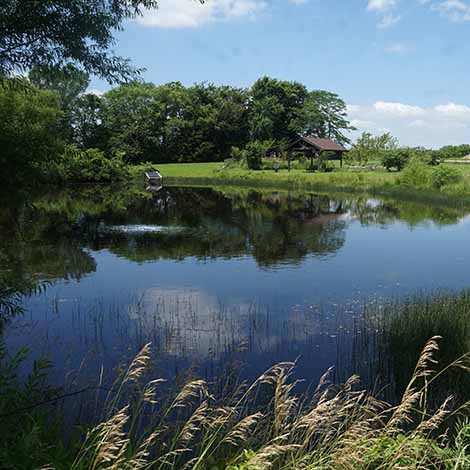Aeration circulates the entire pond's water column, forcing cool, oxygen-deprived water up from the depths. The water bubbles break the surface to release trapped toxic gases, absorb fresh oxygen, and diffuse back into the pond. This circulation and gas exchange cycle helps beneficial aerobic bacteria digest muck and increases the overall dissolved oxygen in the pond.
Without proper aeration, ponds suffer from low oxygen, turbidity, muck, and a buildup of toxins that can kill fish. There are a few ways to tell if your pond has enough aeration and oxygen before it causes problems, including using an oxygen sensor and analyzing temperature differentials.
Signs of Low Oxygen in Ponds
Proper aeration with an aeration system or fountain (in ponds shallower than six feet) is vital to a balanced pond or lake. Proper aeration improves water quality, breaks down organic debris and muck, and promotes a balanced pond ecosystem.
An undersized system will not create uniform circulation. It simply pumps small amounts of cool, nutrient-rich water from the bottom of your pond to the top, adding fertilizer to your pond’s sunny surface. This can result in additional algae growth, especially during the summer. If you notice excessive muck build-up and frequent algal blooms, then your pond likely needs additional air pumps or an aeration tune-up.
You can confirm whether low oxygen and circulation are causing your water quality problems before any fish die by conducting an aeration test. You could invest in an oxygen sensor to directly read the dissolved oxygen in your pond, but these tools can be rather expensive. Instead, see if you can identify thermal stratification layers.
Have you ever swam in your pond and felt cold water at your feet? You might think a cold zone indicates a spring-fed pond, but it is more likely a thermocline. This is caused by thermal stratification—a separation of water layers based on temperature that indicates the water is not mixing thoroughly.
Test Your Pond's Temperature
If you think your aerator isn't working correctly, it's easy to diagnose—just take your pond's temperature! Record temperature readings from various areas and depths of the pond to uncover and pinpoint aeration and circulation issues.
Gather the following supplies:
- Submersible thermometer
- Fishing sinker (if the thermometer floats)
- Long string
- Tape measure
- Waterproof marker
- Stopwatch
- Paper and
- Boat or raft
Tie the string to your thermometer, and measure and mark each foot down the length of the string with your waterproof marker. If the thermometer tends to float in water, secure a fishing sinker or small weight to the bottom of the string.
Hop into your boat and motor to a handful of different locations. Consider your pond’s size and shape and select enough spots to get a complete picture of the overall water temperature.
Drop the thermometer into the water and take the temperature readings at two-foot intervals from the top to the bottom. Let the thermometer rest for a few minutes at each depth to get the actual temperature reading.
Repeat this process in different areas, especially if your lake is unevenly shaped, and jot down the temps all along the way.
Once you've taken your lake's temperature, look at your notes. Is there more than a few degrees difference in any location? If so, your pond is likely under-aerated.
The good news is that The Pond Guy offers a Free Aerial Mapping Service. We can help measure your pond and tell you where the diffusers should be placed so that aeration is even throughout the waterbody. Your fish will thank you for it!
Pond Aeration Tips & Advice
Contact us today at 866-POND-HELP to receive personalized aeration solutions from our friendly pond experts. We’ll help get your pond or lake back in shape in no time!
Read more about pond aeration systems in the following articles:
Types of Pond and Lake Aeration Systems
How to Measure a Pond for Aeration Sizing
Alternative Energy Pond Aeration Options
Can You Over Aerate a Pond
Compressor Maintenance
Last Updated: October 14, 2024

